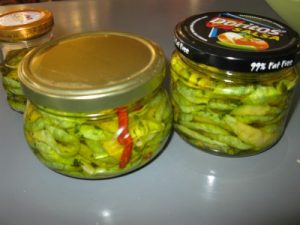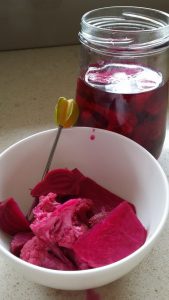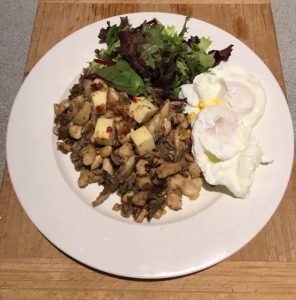Olives straight from the tree need to be experienced once in your lifetime, to show you how incredibly bitter they are! The process of curing – or pickling – olives is needed to draw the bitterness away from the olive flesh and make it edible.
The process is different for green and black olives as the black ones are on their way to becoming more mature than the green. Note that all olives start green and ripen to black or purple. Click here to read about how to cure black olives.
Large, hard green olives, like Kalamata, take longer in the soaking process to be ready. The three methods below are listed in order of the fastest to be ready to the slowest. Note that the fastest methods need more input from you at the start of the process.
For firm, green olives
Crush and de-pip the olives. Using a small bottle with a concave base makes this easier.
Soak in a bucket of water, changing the water daily for up to 14 days, depending on the variety and size of the olive. You can use hot water when changing to speed up the process. Add lemon slices to acidify the water. The olives will change colour from being bright green to more of a brown-green colour.
Once the bitterness has gone (taste them to check), drain the olives, weight them overnight over a colander to press off even more water, then salt to taste. Dress with condiments such as olive oil, chopped garlic, chopped fresh chilli, dried oregano, fennel seeds, etc.
Eat immediately or store in the fridge for a few days.
Variation: after draining the olives, squeeze excess water from them and weight overnight in a colander as above. Then toss through some white wine vinegar for several hours, then press to drain once again. Dress with olive oil, salt, garlic etc and eat; or store in jars, topped with olive oil, with added condiments.
Mrs Louca’s method
Wash the olives. Then crack, leaving the stones in, using the base of a small bottle and immediately place the cracked olives into a bowl of water to prevent the olives going brown. Continue until all the olives are cracked.
Place the olives into jars and calculate how much solution to make. For each litre of solution needed, include the juice of 1 lemon and 200ml white vinegar. The rest of it is made up of a 10% brine solution.
Prepare the 10% brine solution.
Add the juice and the vinegar to the solution.
Fill the jars of olives with the solution.
Place a slice of lemon over the top to help keep the olives submerged. Pour a layer of olive oil over the top to help keep the air out. Seal and store. It is a good idea to place the jars of olives over an old teatowel or other to absorb any leakage as the mixture may naturally ferment.
Taste the olives after one month – they should be ready to eat. If not, seal and store one again.
Simple method (but you will need to wait several months for them to be ready)
This works well especially for olives that are semi-coloured.
Jam pack the olives into a clean glass jar. Top with boiled 10% brine solution, add a lemon slice to the top and then cover with a layer of olive oil to help keep the air out.
Variation: add garlic, chilli, fennel seeds as desired for extra flavouring to the brine solution in the jars.
Author
Maria Ciavarella
Donvale





